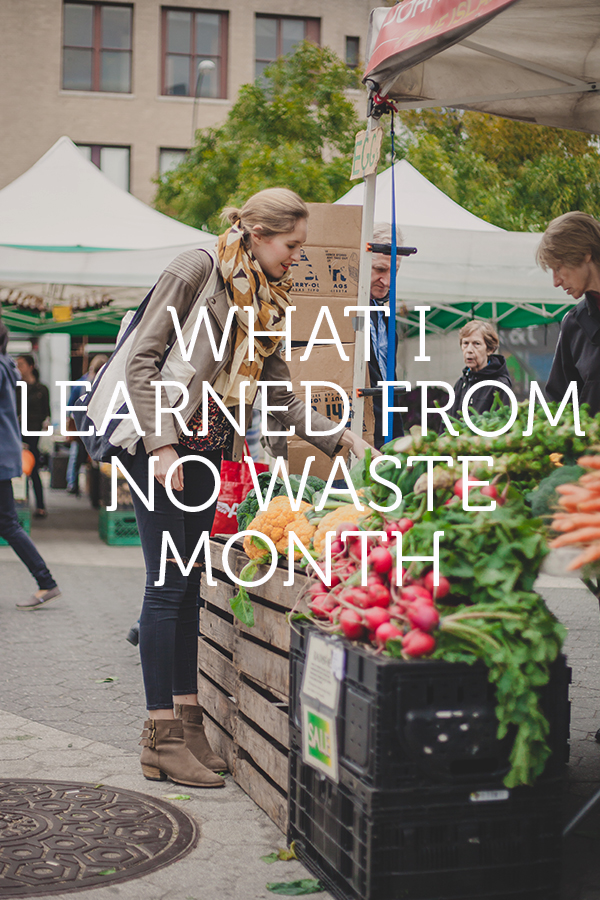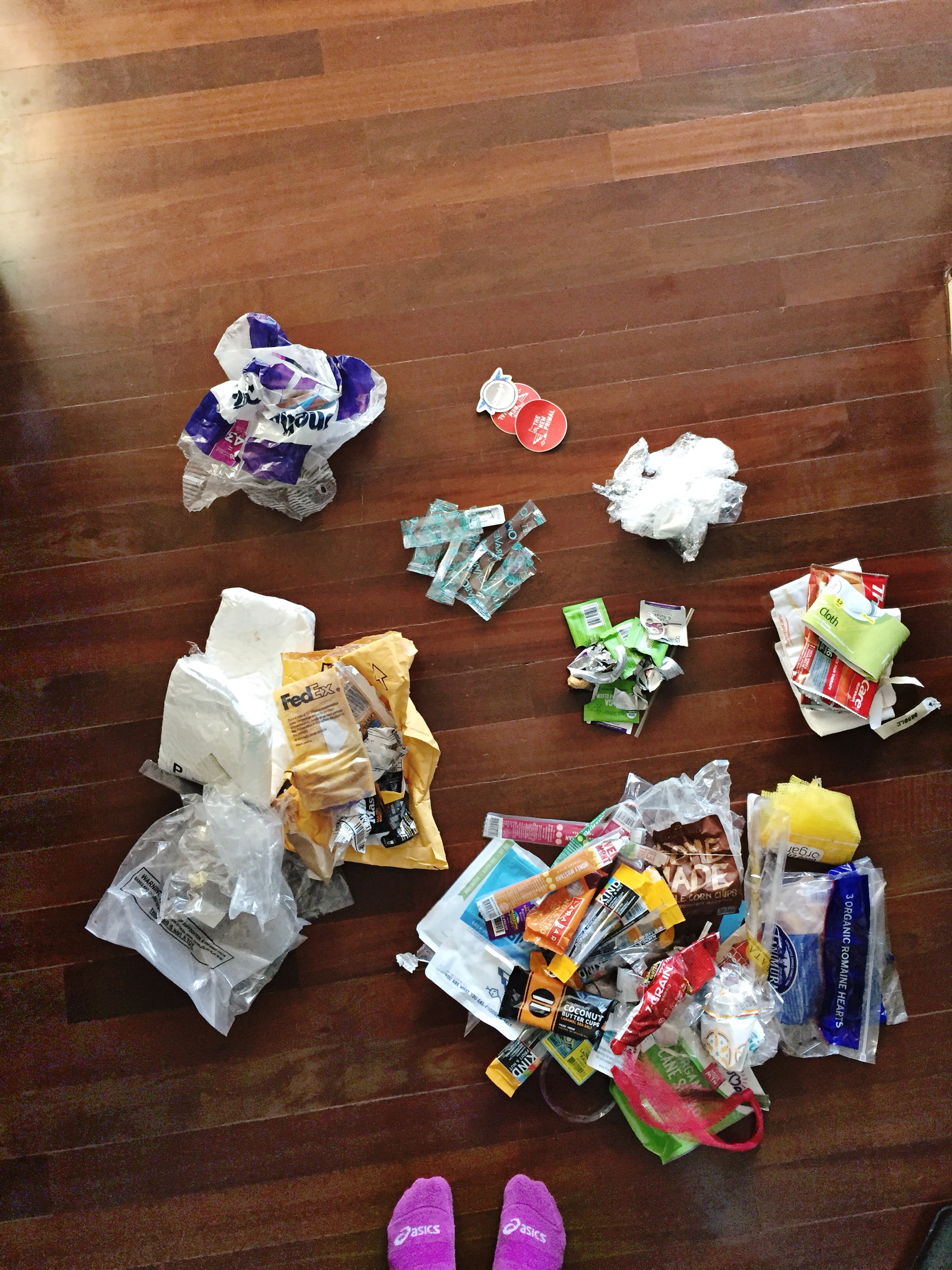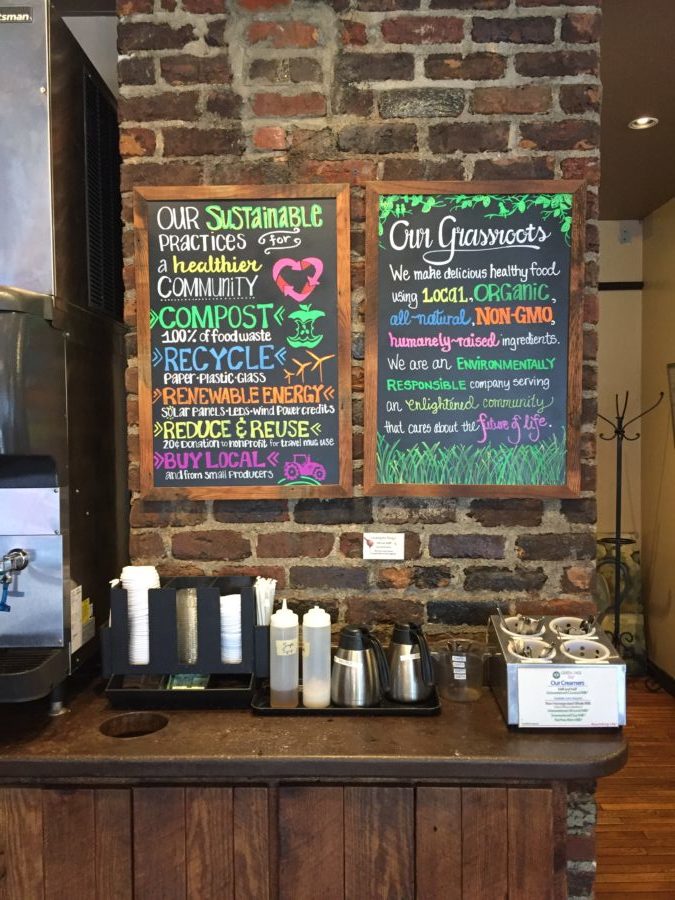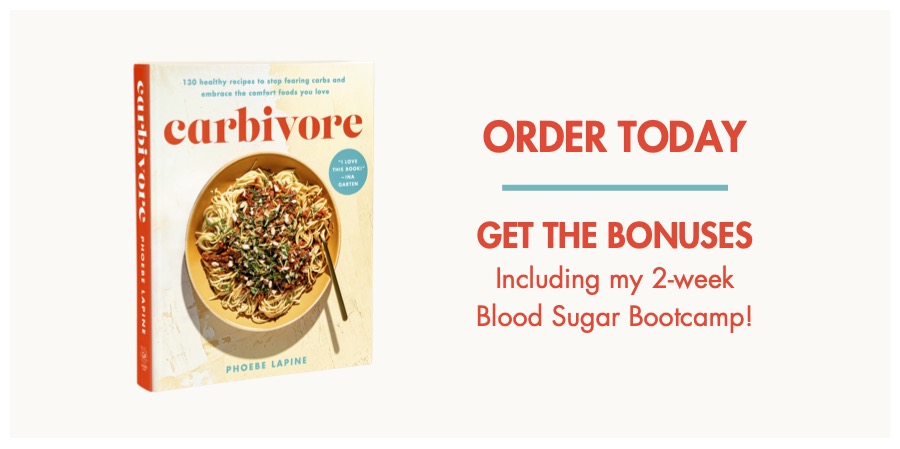One of my biggest lessons from The Wellness Project was that you can’t make healthier choices until you know what choices are healthy for you.
I’d also say that a very necessary pre-curser to this is knowing your baseline. Where your habits currently stand. Not what you think you’re doing, but what you’re actually doing.
After all, you have to diagnose the problem first before you can start finding solutions going forward.
As a lesson in awareness, No Waste Month proved to be incredibly successful. I overthought my choices every time I approached a trash can. I did more Google research on tea bag packets than I’ve ever been motivated to do. And I proved through my own example that we’d all probably create less waste if we simply took the time to learn what we could and couldn’t recycle.
I was both incredibly proud of our efforts, and kind of horrified by the number of Kind Bar wrappers I picked through at the end of the month.
Luckily, we were able to meet our goal of getting through 4 weeks with only one trash bag, even though I accidentally scraped some clam spaghetti into the bag on day two, which required a few sprinkles of baking soda later in the week to control the smell.
It was an incredibly eye-opening experience going through our trash pile last week, and only slightly disgusting thanks to that spaghetti. Those of you who tuned in on Instagram for the live reveal can attest to how much fun I had dumpster diving like a sleazy private eye (a la Matt Dillon circa 1996).
I came across some champagne foil and felt a classic jilted wife pit in my stomach…until Charlie reminded me two minutes later that I had been the lucky recipient of those bubbles in an Aperol cocktail he made towards the beginning of the month.
Again, it’s very easy to forget what we eat, drink and toss if you’re not taking inventory.
We’re hoping to be able to keep the no trash train chugging through the end of the year and beyond. I’ll be putting together some simple tips for reducing your waste for Mind Body Green later this week. But in the meantime, read on for some big lessons from No Waste Month, and a snapshot of my #4WeeksofWaste.
From one healthy hedonist, to another,
Xoxo
Phoebe
UPDATE: Baron pooped all over the apartment yesterday, so we officially have a new trash bag and roll of paper towels in the rotation. Baking soda didn’t seem like it would solve that one. No-Waste parents who use cloth diapers, I solute you.
A DIVE INTO MY DUMPSTER
Here’s what a month’s worth of trash looked like in my home, including some of the brands contributing unnecessary waste, and the biggest parent categories of my pile. To watch the whole unveiling video from my Instagram stories, click here!
Packaged Food
- Lemon / Brussels sprout netting
- Plastic sleeves from chicken, sausages, salmon
- Plastic tags from store bought veggies (Cal Organics is working on this)
- Twist ties for store bought veggies
- Breakfast bar wrappers
- Jerky, meat sticks, prosciutto wrappers
- Plastic bags from romaine hearts and salad greens*
- Cling wrap from food storage*
Packaged drinks
- Plastic-coated tea pouches (Gaia Herbs)
- Plastic-coated powder pouches (Four Stigmatic)
- Plastic bands on the top of kombucha bottles
- Wine foil
- Straws
Shipping
- Bubble envelopes
- Packing tape
- FedEx plastic pouches
- Soft plastic wrappers for new products*
- Styrofoam shippers
- Plastic peanuts (these kill me)
Misc
- Hotel keys (some of these were recyclable when we looked)
- Icy hot back patches
- Stickers (brands, please stop sending me stickers!)
- Plastic wrapper for the tea towels we bought to reduce waste (lol)
- Plastic package for paper towels (that we are trying to use less of)
- Puppy toothpaste chew packaging*
- Swiffer pads
*In New York State, large retailers are required by law to recycle soft plastic. You can save your plastic grocery bags, mailer sleeves, non-food soiled plastic wrapping, and bring them into a location here. This also includes newspaper bags, dry cleaning plastic, and thin plastic film from notecards, tea boxes, pre-packaged cheese, household items, pet food, juice packs, the things starred above etc. No doubt many other states also have similar options. It’s worth checking out. We have begun a recycling bag just for soft plastics.
LESSONS
Waste is something you make on the move.
One of the things that impressed me most about this woman’s No Waste commitment is that she even saved her waste from out in the world. Straws from cocktails, wrist bands from concerts. Everything.
I did not come close to this kind of due diligence or transparency. In fact, when I was out and about, rushing around, I had a much harder time living my no waste message. There’s only so much you can do about travel, which leaves you at the mercy of how sustainable the establishments are that you come into contact with.
But a little preparation can go a long way, be it a reusable water bottle or a brown bag lunch from home. You can ask for no straw with your drink and seek out take away meals that use greener packaging. Even when they don’t, make sure to ASK about whether they recycle.
And lastly, try to put your bottles, containers and utensils in the correct bucket, even if it means walking a few extra city blocks until you find a blue bin. We often give ourselves a free pass when we’re away from home, and just looking at my own mindless tossing on the move, I know we can all do better.
The majority of it comes in the mail.
I knew I had a problem before this challenge began. I vowed to get my mail-order shipping addiction under control this month. But alas, I can’t quit you Amazon Prime.
As much as those packaged food wrappers added up, they paled in comparison to the quantity of waste created from retail purchases and the extravagance of having them delivered to my door.
Folks….we have to buy less shit, and that may involve returning to the days when it was harder to do so at the click of a button.
Unfortunately, you never know what kind of packaging your purchase will come in, so there’s no way to avoid bubble mailers and packing peanuts. Where we do have agency is in not using those materials ourselves. Choose envelopes made from recycled paper at the FedEx store, and avoid those bubbles at all costs.
A lot of our food also comes in the mail.
I realized I could also be better about buying food that doesn’t come on a plane. Which means shopping at the Farmer’s market instead of the grocery store.
I was shocked by how much waste I was creating from simple meals made from whole ingredients. This easy sheet pan dinner contributed a plastic sleeve from the chicken (Whole Foods doesn’t include poultry at the butcher counter), netting from a bag of lemons, a twist tie and plastic tag from the kale, and a plastic bottle topper from the red curry.
It drives home how important it is to shop local, and make sure the stores you’re shopping at are sourcing their wares from local places as well.
Composting cuts your waste in half.
Most of us don’t take the trash out when it’s full. We usually do it when it SMELLS.
The beauty of composting is fewer unnecessary garbage bags. And when you remember to scrape your spaghetti into the right bin, it also means you can search through the trash for secrets without getting rotten tomato sauce all over your hands.
Other strategies for keeping the smell under control: baking soda, a little counter spray, and just taking the time to rinse food-soiled plastic (like those raw chicken sleeves). I also wrapped them tightly with rubber bands (see below).
Things I didn’t know you could compost: tissues, paper towels, wooden takeout chopsticks, cotton balls, Q-Tips, parchment paper.
You can keep your trash at bay by simply looking on the back before you throw something away.
If you watched the dumpster dive video, you know that I threw my partner under the bus for a lot of the trash in the bag. But I was particularly hard on him for the things that he threw away that could indeed be recycled. Some things required a quick Google, but most of the time the information was written right on the back of the package. You just need to take the time to look.
I completely understand being a busy professional and not having the time to lug compost to the Farmer’s market or take soft plastics back to the store. But when it comes to our basic everyday habits at home, time is not a good enough excuse or scapegoat. It doesn’t cost much more than two seconds to take stock of what you’re throwing away and put it in the right bin.
I also didn’t find it took much more effort or time to rinse the food off my recycling. I just needed 21 days of diligent attention to get in the habit.
Things I didn’t know you could recycle: Nespresso pods (return program here), hotel keys, wine corks (more info on that one here and here).
Be willing to reuse in weird, unexpected ways.
Certain things we throw away have a reusable function. The perfect example is rubber bands from produce. I created a space in my kitchen drawer for these and saved them. They came in very handy when I was throwing away something particularly smelly, like the aforementioned plastic sleeve that housed raw chicken. I rinsed it out, carefully folded it up, and then used a rubber band to secure it into a tight wad. No odor!
I rarely use soft plastic bags in the produce section, but for certain things like green beans and Brussels sprouts they are a necessity. We ended up using them as doggie bags latter in the week. The doggie bags we normally use are biodegradable, so I still try to skip the produce bags when possible.
Bully brands into making necessary changes.
One of the themes from this weekend’s WELL Summit is that you have more control than ever now to affect meaningful, sustainable changes in the world. We vote with our dollars. We are the critics writing every day reviews on our platforms. Our opinions matter and they’re constantly being heard.
It’s no surprise that going the extra mile to use green packaging, good ingredients, and fairly-compensated workers makes it that much harder for small food businesses to survive. We need to champion the brands that are doing good in this world and shout from the rooftops so they succeed.
At the same time, we can also push brands we love to be better.
I wrote to Cal-Organics during the challenge to ask if their plastic tags were recyclable. It seemed like a no brainer for a company that claims on their website to invest in sustainability. They wrote back right away that they’re working on it and going to roll out a new tag soon.
Other brands in my pantry that I plan on writing: Gaia Herbs, whose individual tea sleeves are not recyclable. They could very well do away with them entirely like Celestial Seasonings. Four Stigmatic, whose single serve mushroom coffee packets are not recyclable. And finally, my beloved Sweetfin Poke.
As you know, I spent the first week of this challenge in California and was very disappointed to realize that my favorite fast casual spot only uses disposable plastic bowls, even if you tell them that you’re staying to eat. In contrast, my favorite poke place in Brooklyn, Chisai Poke Bar, uses biodegradable paper bowls.
This was something I had never paid attention to before this challenge, and while I don’t plan on boycotting places and brands that don’t meet these standards, I am going to do my best to ask them to change.
More Resources and Ideas:
TerraCycle offers mail-in programs for 50 to 60 different materials that aren’t easily recyclable, like snack packs, granola bar wrappers, chip bags and drink pouches. Their mixed use Zero Waste box is 20 percent off this month using code NOVEMBERBOX20! We are going to order one and see how it goes.
For more advice and resources, check out Emma Loewe’s archive on Mind Body Green.




Thanks for this awesome post Phoebe! I have a couple questions and comments/suggestions based on some of my experiments too. Sorry for the rambling comment but this post spurred my brain thinking and I wanted to share. I have recently seen composting more frequently out in the big world which makes me happy it is slowly becoming more main stream; at a pro sports arena, an airport, and even received an email from my alma-mater that they are now composting!
Can you recycle the foil from wine bottles? I’ve never been sure of this one.
People should check their local composting requirements. The service in my area doesn’t allow tissues but does allow paper towels and napkins. And their website doesn’t comment on q-tips or parchment paper, so I wrote them to ask if those are ok!
In our kitchen I’ve partially switched to using reusable paper towels from this webiste (https://www.marleysmonsters.com/collections/unpaper-towels) for the less gross kitchen cleanup tasks where I would usually reach for a paper towel and although they are a little bit of an investment upfront they have been great and I just wash them to my weekly towel wash.
I try to remember to ask for no tissue paper when I do shop locally and bring my own reusable shopping bag but it doesn’t always happen. We have too many rubber bands so I’m trying to remember to pass on rubber banding eggs at the grocery store now too.
I’m also trying to start remembering to bring more reusable produce bags to the grocery or farmers market (http://amzn.to/2zrltcD). Using mason jars with the empty jar tare on them for bulk items is a goal of mine. I haven’t tried these before but using reusable bags for bulk items seems like a good idea too (https://www.marleysmonsters.com/collections/snack-bags-napkins/products/dry-good-bags).
I also want to try wrapping some gifts this holiday season in reusable fabric or with dish towels as part of the gift to use less paper products. I recently learned about Furoshiki, a Japanese gift-wrapping technique that uses cloth instead of paper!
this is all so so awesome Brittany!! You are a green goddess! very inspired by you and going to look into some of these reusable bags. great idea re mason jar.
cheers!!
Great post !
Now for someone who cooks like CRAZY from scratch , how can I NOT have waste.
I don’t shop everyday and I buy for a week at a time so how do I store my produce other than in plastic bags ? milk cartons produce peels, etc.etc.
Help !!!
How do you do it ?????
haha. a) compost b) don’t use those plastic bags if you don’t have to! I never store my produce in plastic bags. I just throw them in the crisper drawer. c) milk cartons get recycled! So no technically waste because it’s being reused. Obviously it’s impossible to not generate any excess packaging unless you’re shopping exclusively from the farmer’s market, which I certainly don’t have time to do every time! Just be better about recycling what you can. I’m sure it’s more than you think. Keep cooking! That’s a greener move than packaged food and takeout! xoxo
Hi there,
In New Zealand we can get these bags (made of starch) that you can shop with and store fresh produce and sandwiches in. They are washable and reusable, and when they wear out they are fully compostable. Also there is compostable cling film. Maybe there is a similar product in the US. But beware of oxydegradeable products as they don’t breakdown. See the FAQs on the following website.
http://www.friendlypak.co.nz/Products/Bag-Pak/Bags-with-Handles
Ask your supermarkets to bring in starch based compostable shopping bags for you to use and purchase for home.
Another tip is to freeze chicken, meat and fish bones, meat scraps, seafood waste, the pads that absorb the chicken and meat juices in the bottom of the plastic trays, old cheese, dairy etc (anything you can’t compost) in a “bone bag” then put it out in the rubbish (trash) bag on rubbish day. No smelly rubbish bins!
We have to wash out all food contaminated recyclables (plastics, cans, bottles, dairy containers etc) or they won’t be picked up, so I just wash these things along with my dishes. It is just a normal habit to do so now and I have very clean non-smelly recycling!
your country is definitely a role model!! thank you for sharing all of this Melissa! I totally agree that rinsing recycling can become second nature. I used to be terrible at this, but after no waste month I’ve gotten a lot better.
Phoebe I wanted to share one other resource I’ve found helpful to cut down on junk mail and unwanted catalogues. I use this website: catalogchoice.org to unsubscribe from all the catalogues we receive. It takes a little while for the catalogues to stop coming but does make a difference in the end!
this is awesome brittany! thank you for sharing!
Thanks for such an informative post! Definitely puts things into perspective. Quick question: Do you happen to know if the individual meat stick wrappers (e.g. Vermont, Chomps, etc.) are recyclable?
they are in soft plastic (not regular curb side) so long as they aren’t dirty.